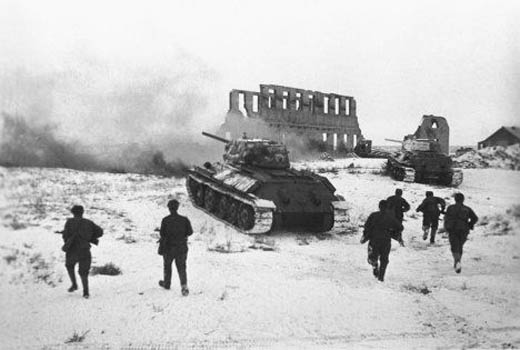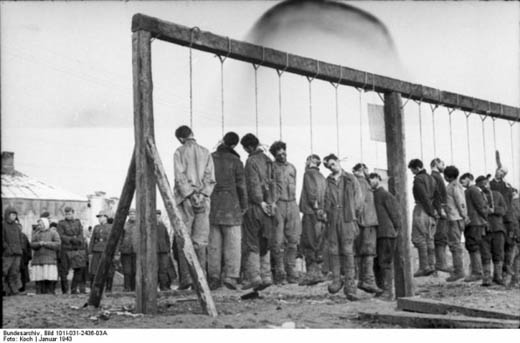Air Operations, CBI
BURMA- 11th Medium Bomb Squadron B-25s based in China and 10 7th Heavy Bomb Group B-24s based in India mount a successful coordinated attack against a bridge at Myitnge.
Air Operations, New Guinea
5th Air Force and RAAF aircraft attack the departing Japanese convoy in the Solomon Sea and dumps and antiaircraft batteries at Lae.
[Air Operations, Solomons
- Cactus Air Force SBDs and P-39s attack Japanese Army ground troops and an ammunition dump on Guadalcanal.
- AirSoPac B-26s attack Munda.
- 1 B-26 is lost.
Air Operations, Tunisia
- XII Bomber Command B-26s attack the marshalling yards and oil depot at Gabes.
- XII Fighter Command A-20s and P-40s attack the Axis military camp at Kebili.
- IX Bomber Command B-24s attack La Goulette after being diverted from Bizerte by bad weather.
- 6 Bf-109s strafte the 33rd Fighter Group's advance fighter base at Thelepte.
Eastern Front
Since von Paulus has ignored his ultimatum of the 8th, Rokossovsky launches a great new offensive, Operation RING, against the perimeter of the German 6th Army and the other German forces surrounded at Stalingrad. They nominally have 7 armies and the Germans the equivalent of 2, but Russian armies are only the same size as a German corps. The 62nd and 64th Armies on the east and southeast of the circle are particularly under strength. All the Russians forces move to the attack but the main effort is by the 65th and 21st Armies to the west. The attack goes in after the usual fierce barrage. Although von Paulus knows that the struggle is hopeless, he still fights on. He holds out, not only in obedience to orders, but for strategic reasons. By keeping the greatest possible number of Russian divisions engaged he will relieve pressure on the Don Army Group and von Kleist's Army Group A, which is in danger of being trapped in the Caucasus.
SOUTHERN SECTORThe Don Front (281,000 troops, 257 tanks and 10,000 artillery pieces) commences Operation RING, the destruction of the German 6th Army at Stalingrad. Facing this force are the freezing 191,000 troops of the 6th Army, with 7,700 artillery pieces and 60 fuel-starved tanks.
Soviet Troops Launch an Offensive |
 |
Operation KOLTSO opens at 0650 hours with a colossal arty bombardment. The barrage is followed by infantry and armored attacks. Elements of the 24th Army crashes into the 113th and 76th Infantry Divisions, while the 65th Army strikes the 384th, 44th and 376th Divisions as it advances toward Karpovka. The 21st and 57th Armies cut throught the Marinovka nose, battering the 3rd and 29th Divisions mercilessly. Under continual attack by the Don Front and harassed by the 16th Air Army, the 6th Army begins to disintegrate. Only the 297th and 113th Infantry Divisions survive the attacks, the remainder being wiped out almost to a man. Scattered bands of hunted men retreat across the steppe to the Rossoshka River and Stalingrad, many falling as the Soviets begin a close pursuit.
In the Caucasus, the Soviets begin to attack across the Kuma. The XL Panzer Corps has pulled most of its forces back, only rearguards holding a skeletal line. To the west the XLIX Mountain Corps pulls back toward Maikop.
Mass Execution of 'Partisans' |
 |
Guadalcanal
The reinforces 25th Div begins the largest and final offensive to clear Guadalcanal. The immediate objectives of the operation are the Galloping Horse, the Sea Horse and the Gifu strongpoint. After a half hour artillery preparation, the first divisional time on target concentration of the campaign, followed by an aerial bombardment, the 27th Infantry drives southward through the 2nd Marine Div against the Galloping Horse and clears more than half of the objective. The 1st Battalion, on the west, attacks from Hill 66 to the objective, the north part of Hill 57, and establishes patrol contact with the 3rd Battalion to the east. From Hill 55, the 3rd Battalion advances 1,600 yards toward Hill 53, but is halted by stubborn opposition on Hill 52, an intermediate position. The 35th Infantry's 3rd Battalion begins an envelopment of the southern flank of Sea Horse, omitting preparatory fire, and takes a preliminary objective, a small hill a short distance south of the Sea Horse, against scattered opposition. Combat patrols of the 2nd Battalion move against the Gifu after preparatory fire but are unable to make any progress. The Americans now have well over 50,000 men on Guadalcanal and the Japanese less than 15,000, all of whom are desperately short of food.
During the night 8 Japanese destroyers attempt to bring supplies. 1 is damaged by PT boats.[MORE]
[Gulf of Mexico
The US freighter Norwalk is sunk in a collision with the Norwegian freighter Nidareid north of Cuba losing 1 of her crew in the incident.
[New Guinea
Units of the US 127th Inf Regiment succeed in establishing a bridgehead over the Konombi near Tarakena. The 1st Battalion, US 163rd Infantry, advance in the area of Kano and Musket, where the Japanese have already evacuated some of their positions. Kano is renamed Fisk after 1st Lt Harold R. Fisk. The 3rd Battalion, 163rd Infantry, reaches the front.
[North Africa
LIBYAGen Montgomery briefs his assault forces of the British 8th Army on the projected drive through the Buerat line to Tripoli, which must be accomplished within 10 days, beginning on the 15th, in order to avoid supply problems.
[Occupied France
Milice Nationale, secret police force, is created in Vichy France headed by Joseph Darnand, one of the heroes of the Forbach Wood Incident. (See February 8, 1940.)
[Pacific
- The giant US submarine Argonaut (APS-1) is lost off southeast of New Britain in an attack on a convoy.
- The Japanese destroyer Okikaze is sunk by the US submarine Trigger (SS-237) off Honshu, Japan.